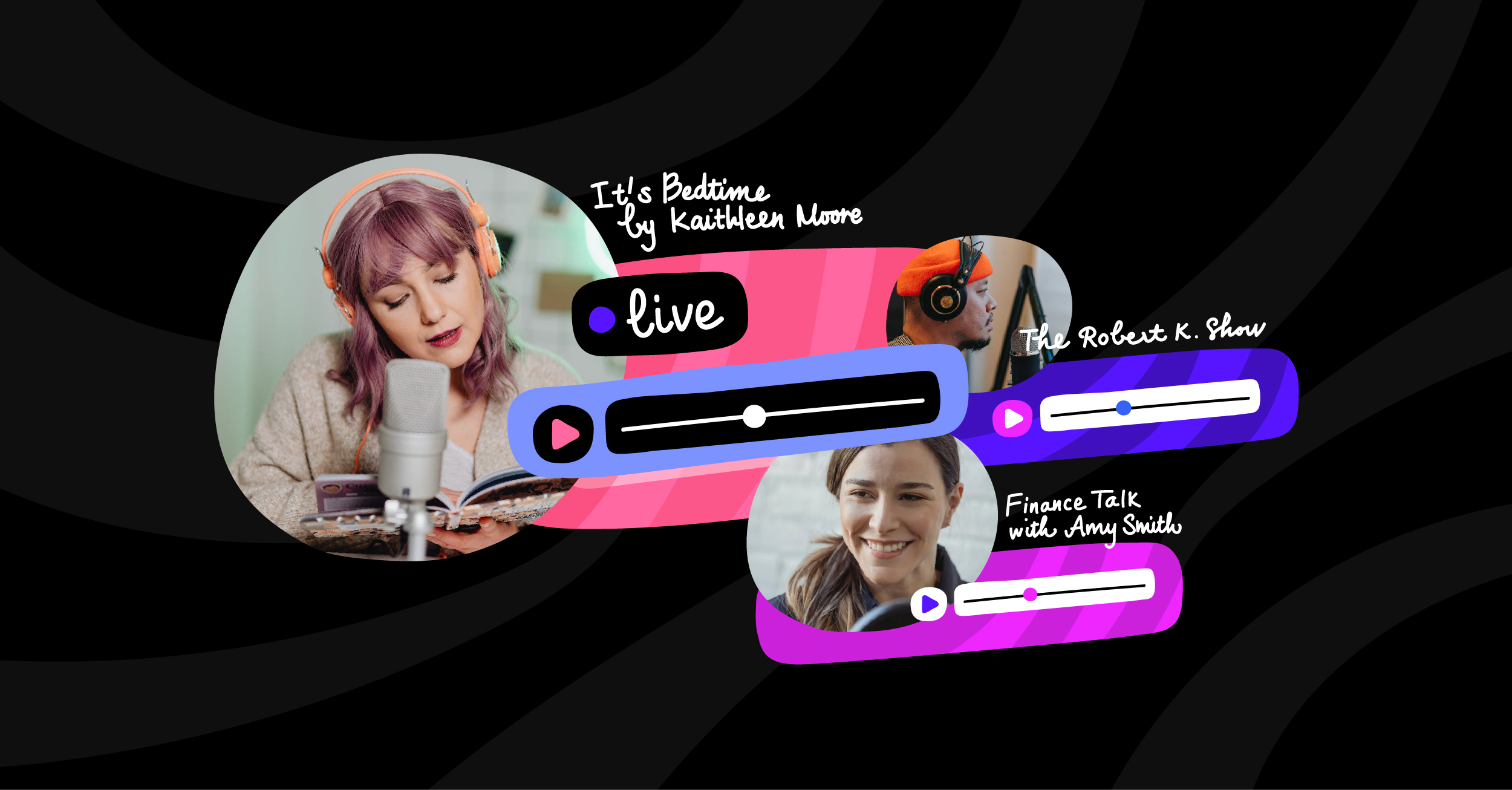Audio streaming has become a powerful medium for content creators and businesses alike. According to “The Infinite Dial” report by Edison Research in 2023, 42% of Americans ages 12 and older have listened to a podcast in the past month. This surge in audio consumption presents a golden opportunity for broadcasters.
One effective way to leverage this trend is through audio-only streaming, which consumes less bandwidth than video streaming and offers convenience for listeners who can engage with audio while multitasking.
Many content creators struggle with the technical aspects of broadcasting live audio online. They often find it challenging to set up and manage their streams effectively. However, streaming audio files can be a breeze with the right tools.
Castr offers an easy solution for broadcasting audio online. This user-friendly platform simplifies the process, making it accessible to beginners and experienced broadcasters.
In this guide, we’ll walk you through the steps to broadcast audio online using Castr.
What is Live Audio Streaming?
Live audio streaming is the real-time transmission of audio content over the internet. Broadcasting live audio allows broadcasters to instantly share their content with listeners worldwide, with applications for various contexts such as podcasts, radio stations, and live events. This technology has revolutionized how we consume audio content, from music and podcasts to live radio shows and events.
The importance of live audio streaming cannot be overstated. It offers a direct and intimate connection between broadcasters and their audience. This immediacy creates a sense of community and engagement that recorded content often lacks.
Live audio streaming has numerous applications. Online radio stations use it to reach global audiences. Podcasters leverage it for live episodes and Q&A sessions. Musicians stream live performances to fans worldwide. Even businesses use it for internal communications and webinars.
The potential of live audio streaming continues to grow. As internet speeds improve and mobile devices become more powerful, the reach and quality of audio streams will only increase.
Why Should You Consider Broadcasting Audio Online?
Broadcasting audio online offers numerous benefits for content creators and businesses. It provides a cost-effective way to reach a global audience without expensive traditional broadcasting equipment. This accessibility has democratized content creation, allowing anyone with a good idea and a microphone to find their audience.
Live audio streaming is incredibly versatile. Podcasters can engage with their audience in real-time, asking questions and fostering a sense of community. Radio shows can expand their reach beyond local airwaves, attracting listeners worldwide. Musicians can perform live concerts for fans who can’t attend in person.
The growing popularity of audio-only streams highlights their convenience for multitasking listeners, making them an attractive option for both content creators and audiences.
The intimacy of audio content is another key advantage. Unlike video, which demands full attention, audio can be consumed while multitasking. This makes it ideal for reaching busy audiences who might listen while commuting, exercising, or working.
Recent statistics highlight the growing popularity of audio streaming. According to Edison Research, 42% of Americans aged 12 and older listen to online audio weekly in 2023. This represents a massive potential audience for broadcasters.
The podcast industry, in particular, has seen explosive growth. According to the Interactive Advertising Bureau, podcast ad revenue in the US is expected to surpass $2.28 billion by 2023, marking a 25% year-over-year increase. This indicates a strong market for audio content and potential monetization opportunities for broadcasters.
Live audio platforms have also gained traction. Clubhouse, for example, grew from 600,000 users in December 2020 to 10 million weekly active users by February 2021. This rapid growth demonstrates the appetite for live, interactive audio content.
For businesses, audio broadcasting can be a powerful tool for internal communications, training, and customer engagement. It offers a more personal touch than written communications and can be more convenient than video calls for large groups.
Essential Equipment for Live Audio Streaming

To start broadcasting audio online, you’ll need some basic equipment. While you can get started with just a computer and its built-in microphone, investing in quality gear will significantly improve your stream quality.
Microphone:
A good microphone is crucial for clear audio. USB microphones like the Blue Yeti or Audio-Technica AT2020USB+ are popular choices for beginners. They offer good sound quality and plug directly into your computer.
Consider dynamic microphones for more professional setups. These require an audio interface but provide superior sound quality.
Audio Interface:
You’ll need an audio interface if you’re using an XLR microphone. This device connects your microphone to your computer and converts the analog signal to digital. The Focusrite Scarlett series is a popular choice for its quality and affordability.
Headphones:
A good pair of headphones is essential for monitoring your audio. Closed-back headphones like the Sony MDR-7506 or Audio-Technica ATH-M50x are ideal for blocking out external noise.
Computer:
Any modern computer should be capable of handling audio streaming. However, ensure it has enough processing power and a stable internet connection for smooth streaming.
Software:
You’ll need software to manage your stream. This is where Castr comes in. It’s a comprehensive audio streaming software that handles everything from encoding to distribution. Effective methods to stream audio files are crucial to ensure reliable delivery and quality of streamed content.
Pop Filter:
This inexpensive accessory reduces plosive sounds (like ‘p’ and ‘b’ sounds) that can cause audio spikes.
Acoustic Treatment:
While not essential, acoustic panels or foam can significantly improve your sound quality by reducing room echo and background noise.
Remember, you don’t need to buy everything at once. Start with the basics and upgrade as you grow. The most important factors are a decent microphone and reliable streaming software like Castr.
How Does Castr Make Audio Broadcasting Easy?
Castr is a powerful and user-friendly audio streaming platform designed for both businesses and individual broadcasters. It offers a comprehensive solution for all your audio streaming needs, making it easy to broadcast high-quality audio to your audience.
One of Castr’s key features is its support for audio-only live streaming. This allows you to focus solely on your audio content without worrying about video production. You can easily stream live audio sessions directly to your website, reaching your audience where they’re most comfortable.
Castr also offers the flexibility to record audio files and schedule them for live broadcasts at any time. This feature is particularly useful for podcasters or radio shows that want to pre-record content but maintain the feel of a live broadcast.
For those looking to monetize their content, Castr provides options for both paywall and advertising integration. You can easily set up pay-per-view events for exclusive audio content or incorporate ads into your streams for additional revenue.
One of Castr’s standout features is its ability to repurpose live broadcasts into on-demand audio content. This allows you to extend the life of your live content, making it available for listeners who couldn’t tune in live.
Castr uses adaptive bitrate streaming to encode your audio files on-the-fly. This ensures that your listeners receive the best possible audio quality based on their internet connection speed.
Security is a crucial concern for many broadcasters, and Castr addresses this with robust privacy features. You can secure your live audio streams against unauthorized access, protecting your content and your audience.
For broadcasters looking to reach audiences on OTT platforms like Roku or Apple TV, Castr provides HLS URLs. This allows you to broadcast your audio content to a wide range of devices and platforms.
Castr’s multistreaming capability is another powerful feature. You can simultaneously broadcast to over 30 platforms, maximizing your reach without increasing your workload.
The platform also offers an HTML5 embed player that you can easily integrate into your website. This ensures that your audio streams are accessible and play smoothly across different devices and browsers.
Castr’s 24/7 broadcasting capability is perfect for online radio stations or continuous audio streams. You can keep your content flowing around the clock, ensuring that your audience always has something to listen to.
With all these features, Castr provides a complete solution for audio broadcasting. Whether you’re a podcaster, radio host, musician, or business, Castr offers the tools you need to create, distribute, and monetize your audio content effectively.
Setting Up Your First Live Audio Stream with Castr
Getting started with Castr is straightforward. Here’s a step-by-step guide to set up your first live audio stream:
- Sign up for Castr: Visit the Castr website and sign up for a free 7-day trial. No credit card is required, allowing you to explore all features risk-free.
- Log in to your Castr Dashboard: Once you’ve created your account, log in to access your dashboard.
- Create a new livestream: Click on the “Livestreams” menu and select “ALL in ONE stream”.
- Name your stream: Give your stream a name that reflects its content or purpose.
- Select hosting location: Choose the server location closest to your target audience for optimal performance.
- Add streaming destinations: Castr allows you to multistream to over 30 platforms. Select your desired destinations.
- Start streaming: With everything set up, you’re ready to stream audio and start your audio broadcast.
Remember, you can always modify these settings later as you become more familiar with the platform.
Best Practices for High-Quality Audio Broadcasts
To ensure your audio broadcasts are of the highest quality, consider these best practices:
Streaming audio has become increasingly important in the music industry, allowing content distributors to reach larger audiences by overcoming geographical limitations, especially with the advent of 5G technology that promises enhanced streaming experiences.
Invest in a good microphone: A quality microphone makes a huge difference in sound quality.
Use a pop filter: This reduces plosive sounds that can distort your audio.
Find a quiet space: Minimize background noise for clearer audio.
Test your equipment: Always do a sound check before going live.
Monitor your levels: Ensure your audio isn’t too loud or too soft.
Prepare your content: Have a clear plan for what you’ll cover in your broadcast.
Engage with your audience: Interaction keeps listeners engaged and coming back.
Engaging Your Audience During Live Audio Streams
Audience engagement is crucial for successful live audio streams. Here are some tips:
Encourage questions: Ask your audience to submit questions before or during the stream.
Use social media: Promote your stream and engage with listeners on social platforms.
Create interactive segments: Polls or Q&A sessions can boost engagement.
Respond to comments: Castr’s chat overlay feature allows you to read and respond to audience comments across multiple platforms.
Monetizing Your Live Audio Content
Castr offers several ways to monetize your audio content:
Paywall: Host pay-to-watch events for exclusive audio content like special podcast episodes or live music performances.
Advertising: Generate extra revenue by incorporating ads into your streams.
Sponsorships: Use your analytics data to attract sponsors for your content.
Video streaming platforms offer monetization tools that can also be beneficial for audio content creators, providing features like robust analytics and monetization options that appeal to both audio and video content creators.
Analyzing Your Audio Stream Performance
Castr provides robust analytics to help you understand and improve your broadcasts:
View listener numbers and engagement metrics.
Analyze peak listening times to optimize your broadcast schedule.
Track audience demographics to tailor your content.
Monitor technical performance to ensure high-quality streams.
Use these insights to refine your content strategy and grow your audience.
Conclusion
Live audio streaming offers exciting opportunities for content creators and businesses. With Castr, broadcasting high-quality audio online has never been easier.
From setting up your first stream to engaging your audience and monetizing your content, Castr provides all the tools you need. Its user-friendly interface and powerful features suit beginners and experienced broadcasters.
Remember, successful audio broadcasting takes practice. Start with the basics, experiment with different formats, and always focus on providing value to your listeners.
Ready to start your audio broadcasting journey? Sign up for Castr’s 7-day free trial today. No credit card is required. Experience firsthand how easy it can be to share your voice with the world.







